12 Ways to Track SEO Performance (+ How to Measure)

Hand off the toughest tasks in SEO, PPC, and content without compromising quality
Explore ServicesAfter putting in all the time, effort, and resources into implementing a new organic marketing campaign, you should know how to measure SEO performance. It’s important to know what’s working, what isn’t working, and why. That way, you will be better able to fix mistakes and refine your strategy so your next campaign can be even more successful.
But what’s the best way to track SEO performance?
There is an untold number of SEO tools, metrics, and reports you can use for measuring SEO over time. It can be challenging to know the best way to report on your campaign’s success.
That’s why we’ve written this guide outlining the best ways to for tracking your campaign’s performance. You can learn about the best metrics and SEO reporting software to use that will make your reporting much easier and more insightful.
Tracking SEO Performance
First, let’s establish the best ways of tracking your SEO success:
- Keyword Rankings
- Backlink Growth, Quantity, and Quality
- Organic Search
- Track & Analyze Your Lowest Organic Traffic Earners
- Track Your Conversions
- Track Behavior Flow
- Time Spent on Page
- Bounce Rate
- Mobile Traffic
- Returning Visitors and Direct Visitors
- Click-Through Rate (CTR)
- Domain Authority
We’ll look into each one in more depth further down.
But first:
What is SEO Performance?
SEO performance refers to how SEO professionals and SEO agencies track the success or failure of a website’s organic traffic. It is how teams can measure the impact of their strategies and continue to see how successful a website is at driving business.
There are numerous ways to indicate the performance of an SEO campaign. Which methods you use will depend on the type of campaign and strategies you used and how you most want to measure success.
So, How Do You Track SEO Performance?
So, how do you measure the success of your SEO campaigns?
What analytics should you be tracking?
These are questions that businesses commonly ask us.
In general, we find that it’s best to use Google Analytics to track SEO performance over time. It offers the most in-depth and variety of metrics of your website’s organic search performance.
Monthly SEO packages 📅
Give us your site or clients and we’ll get to work on improve organic traffic. We’ll audit the site, then create a content strategy and build links that will move the needle… every month.
How to Start Tracking SEO Performance
So you want to start measuring SEO but not sure where to start? Or maybe you know what to track, but are bogged down in deciding on SEO KPIs?
It doesn’t have to be complicated, here 12 things you can (and should) start tracking right now.
Let’s get started:
1. Keyword Rankings

One of the most critical factors for driving revenue through your business’ website is by having strong organic keyword rankings. This is because having your site rank high for your most essential keywords means it is more likely to reach its maximum potential traffic, you can use tools such as the rank tracker from SE Ranking, Ahrefs, Link-Assistant, or SEMRush. You can set them up to track your target keyword rankings for both organic and local SEO.
For example, let’s say you want to rank for dentist-related keywords.
You want to do keyword research to find commercial and informational terms related to dentists, like:
- Book a Dentist in [location]
- Dentist near me
- How much do dental implants cost?
Niching down is important here. Doing effective dental SEO like in this example requires you to do keyword research into the industry you are ranking. It doesn’t matter if it’s dentists, plumbers or SAAS, you need to find the relevant terms to target.
Why is it so important? Because picking the wrong keywords and ranking poorly means you are losing out on that potential traffic and leads, conversions, and revenue.
But you don’t want to rank high for just any keyword.
You want to rank high for the keywords that are most relevant to your business goals — your products, services, and locations. You can use tools such as the rank tracker from Ahrefs, Link-Assistant, or SEMRush. You can set them up to track your target keyword rankings for both organic and local SEO.
2. Backlink Growth, Quantity and Quality

Backlinks to a website have long been one of the main ranking factors that search engines use in their algorithms. However, by now, it’s not just the number of links your website has generated due to black hat SEOs abusing it to game the system.
Now, you need to take into account things like having a steady backlink growth over time and having links from quality and relevant websites (aka link relevance). That, combined with the number of backlinks you have, will give you the best indications on your SEO performance.
Many handy SEO tools include features and reports on your backlink profile. You can use Moz’s Link Explorer, Ahrefs’ Site Explorer, or Monitor Backlinks to show all of those metrics and more.
3. Organic Search
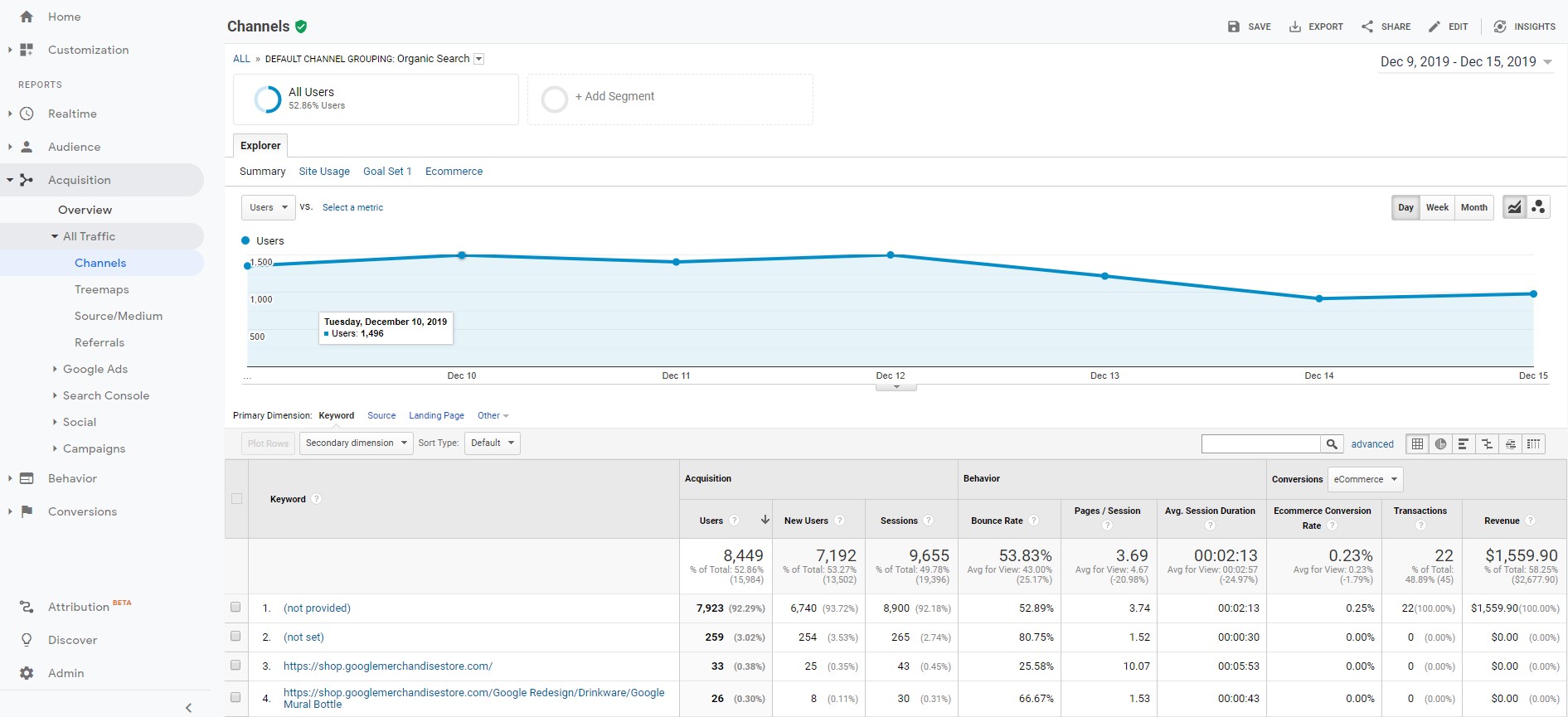
Things like keyword rankings and your backlink profile are essential to break down how you get more organic traffic. However, the goal of improving your keyword rankings and getting more links is to generate more organic traffic.
In general, the metric that has the strongest correlation with driving revenue through your SEO efforts is Organic Search Traffic. If you increase the number of organic sessions to your website, you will typically also increase the leads, conversions, and sales.
The best way to track your organic search performance is still in Google Analytics. You can find other SEO tools that will show you organic sessions, but they will cost money. Google Analytics is still free and connects directly to your website.
You can find your organic data by logging into Google Analytics, and in the sidebar menu, select Acquisition > All Traffic > Channels. You can either click on “Organic Search” in the report or click on the segments at the top of the report and choose “Organic Traffic.”
4. Track & Analyze Your Lowest Organic Traffic Earners
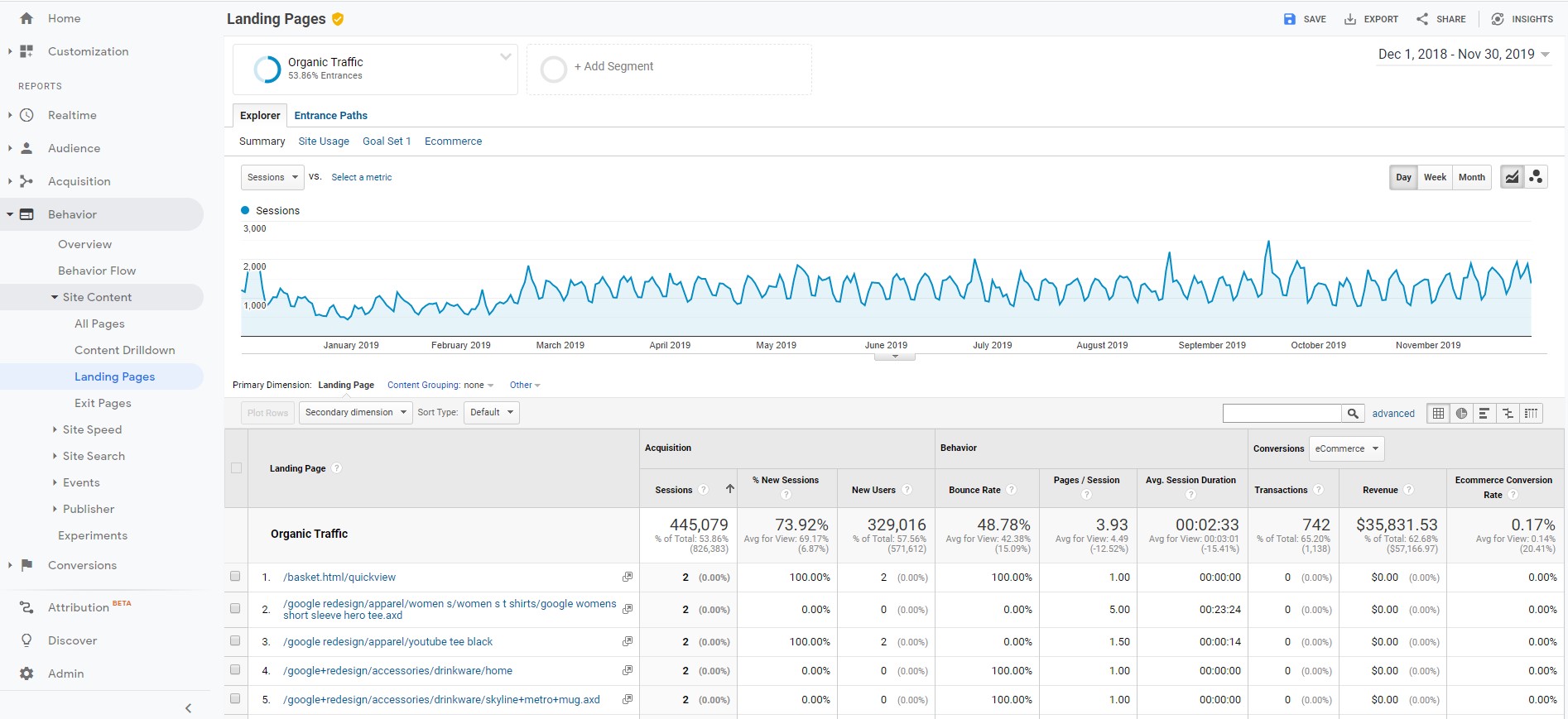
If you have an older website, you likely have a lot of old content and pages that you haven’t thought of in a long time. It’s time to go back through all of your website’s pages to identify which ones are earning the lowest amount of organic traffic.
These can represent significant opportunities to update your old content, so they perform better organically once again. It could be because the content information is well out of date, and users don’t find it useful anymore. It could also be because of technical problems you never noticed, such as images or links being broken.
To find these opportunities, sign in to your Google Analytics account and choose the following from the sidebar menu: Behavior > Content > Landing Pages. Choose only the “Organic Traffic” segment to filter for those pages, set the date range to the past year, then sort the results by lowest to highest sessions.
You will now see what pages get the lowest amount of organic traffic. Check each page to see if there are easy fixes you can make to update the content. If you think it’s not worth the effort for whatever reason, you can also remove the page and redirect it to a more relevant page.
5. Track Your Conversions

The ultimate goal of any SEO campaign you run should be to generate more conversions. It could be someone submitting a lead to book an appointment or purchase a product from your website. These are what will be the best indication your campaign is driving direct revenue.
It’s all well and good to have high keyword rankings and lots of organic traffic. However, if your website is not generating conversions, then you need to overhaul your site until it does.
It could be as simple as adding more or better links to send people to your conversion pages. Or maybe your conversion pages are not structured well or have a technical issue that prevents people from making a purchase or filling out a form.
You will need to set up goals and events in Google Analytics to track conversions on your website. You can find this under the Settings > Admin > Goals, and start setting up goals for form submissions, phone calls, and/or eCommerce purchases.
That way, you will be able to see what landing pages, devices, locations, and more are leading to conversions and what isn’t.
6. Track Behavior Flow
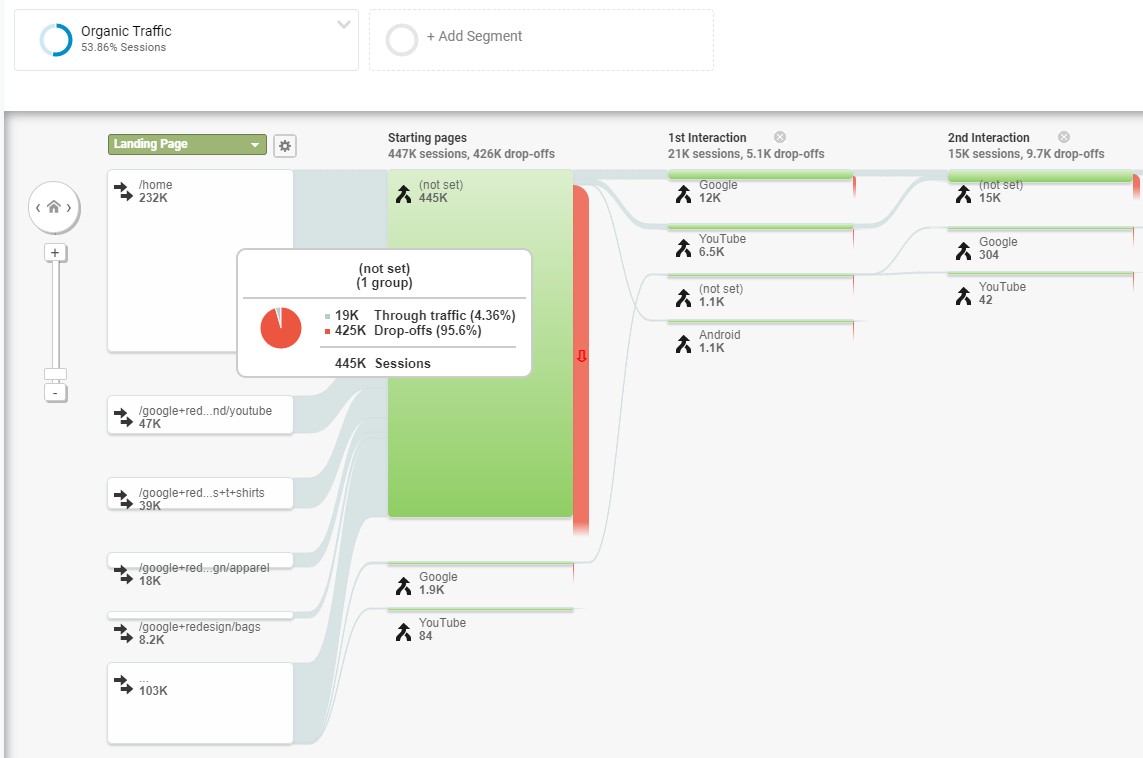
Behavior flow is a very useful report in Google Analytics that can help show you how people navigate your website. It’s beneficial to see the path people take who lead to successful conversions, and where people may be hit a dead end.
Under your Google Analytics account, go to Behavior > Behavior Flow in the sidebar. You can set the flow chart according to traffic source (organic), landing pages, and more. For SEO performance, you want to see where people are dropping off or exiting your website when they do NOT convert.
You can then look at those exit pages to try and fix them so more people wind up converting. Or, you can redirect that page to a different one that is similar and performs better.
7. Time Spent on Page
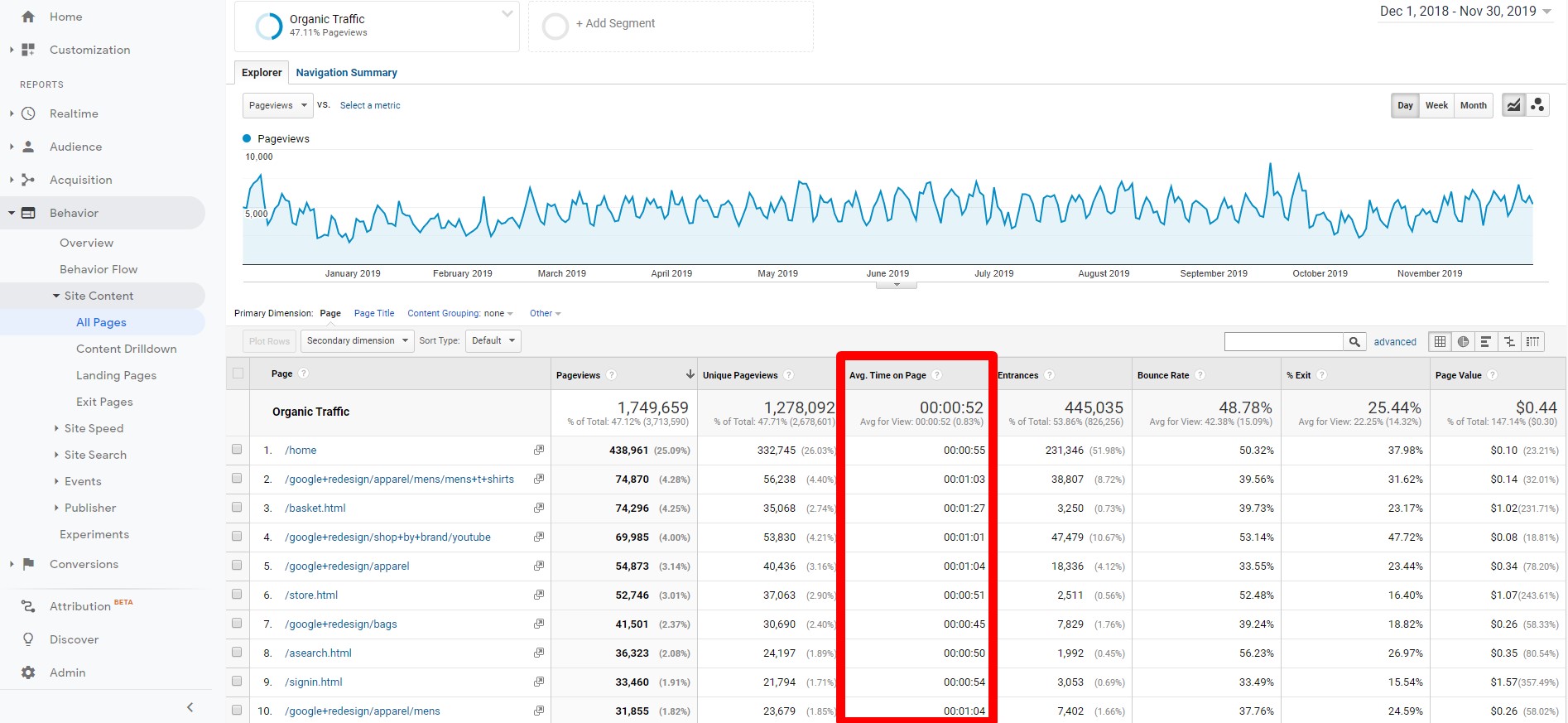
Some metrics, like keyword rankings, are essential to help you track how likely you are to get people to your website. However, you also need metrics to assess the behavior of users once they’re on your page. Time spent on a page is another metric you can add to Conversions and Behavior Flow.
In general, if your users spend more time on a page on average, it’s more likely that they find the information on that page useful and interesting. That behavior signal also correlates well to someone being more likely to convert at some point.
To find this data, go to Google Analytics and select behavior> Site Content > All Pages, then look for the Avg. Time on Page column. Once you select the Organic Traffic segment, you will be able to see that metric for each page on your site. You can compare each page against your site average or industry bookmarks to see what pages are lagging and could be fixed.
8. Bounce Rate

Another good behavioral signal for how your SEO performance is faring is Bounce Rate. This metric shows you the percentage of users click on a link to your website and leave without performing any other action. In general, it’s an excellent signal to assess the quality of a page.
A higher bounce rate, in general, is a bad sign. It’s a good idea to combine this with the Average Time on Page metric, however. For example, if you have an extensive guide article that has a high time on a page AND a high bounce rate, is that a success or a failure? In general, we would say that people found the information they needed when they left so that it would be a success.
However, if you have a high time on page for an eCommerce or appointment form page with a high bounce rate? That’s still bad, and there might be some technical problems that are preventing people from converting that you will need to fix.
9. Mobile Traffic
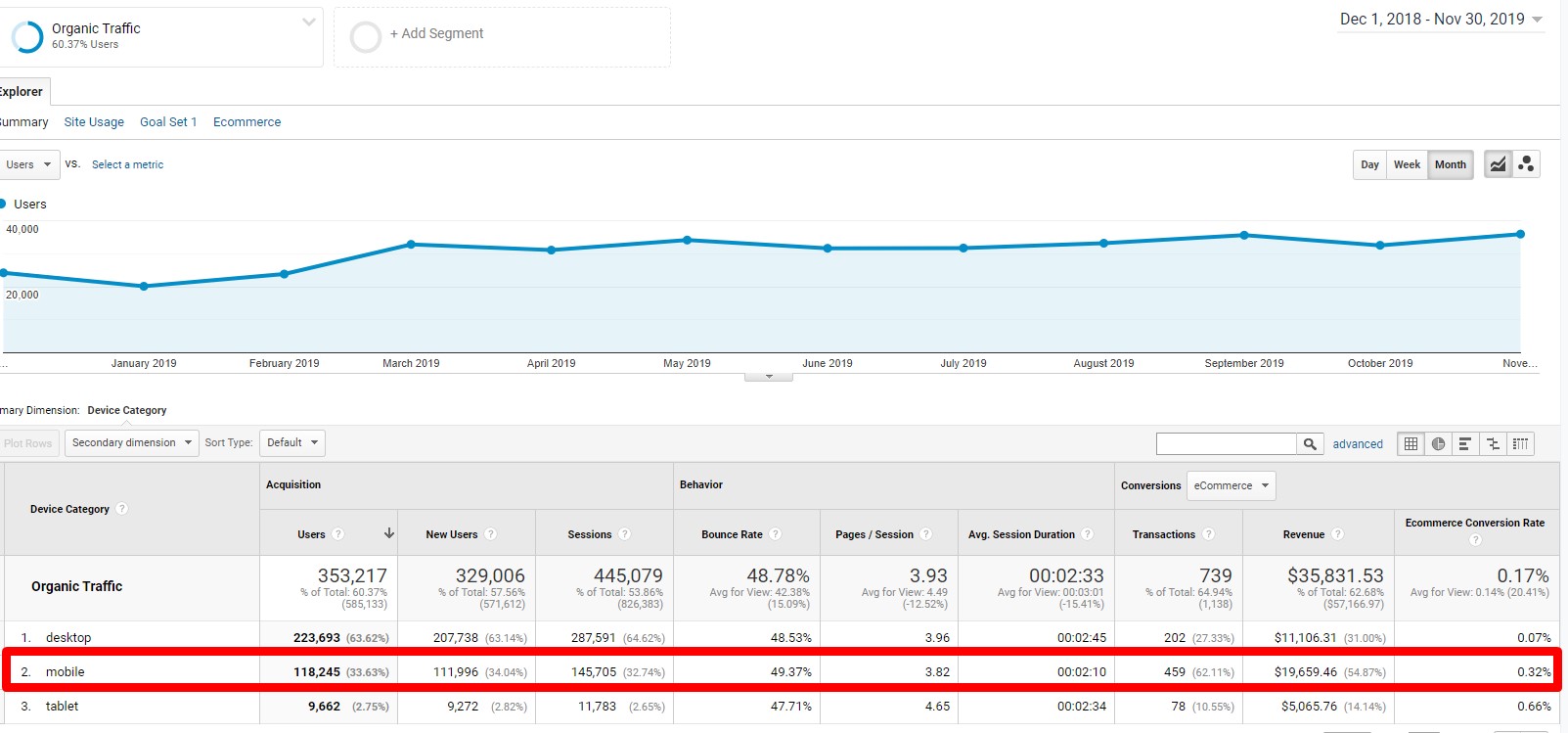
With half or more of all users online doing so from a mobile device, tracking your mobile SEO performance is more critical than ever. How you optimize your pages, content, and website design on mobile should be different than how you do it on a desktop.
The difference in screen sizes, ability to click and engage with your forms or product pages, is too great to do the same thing. If you want to see how well your website is optimized for mobile, you can check in Google Analytics and select Audience > Mobile > Overview.
If your organic traffic on mobile is lagging behind desktop, you have a problem. In this report, compare your desktop vs. mobile performance in total sessions, behavioral metrics like bounce rate, and conversion rate, you have a problem.
10. Returning Visitors and Direct Visitors
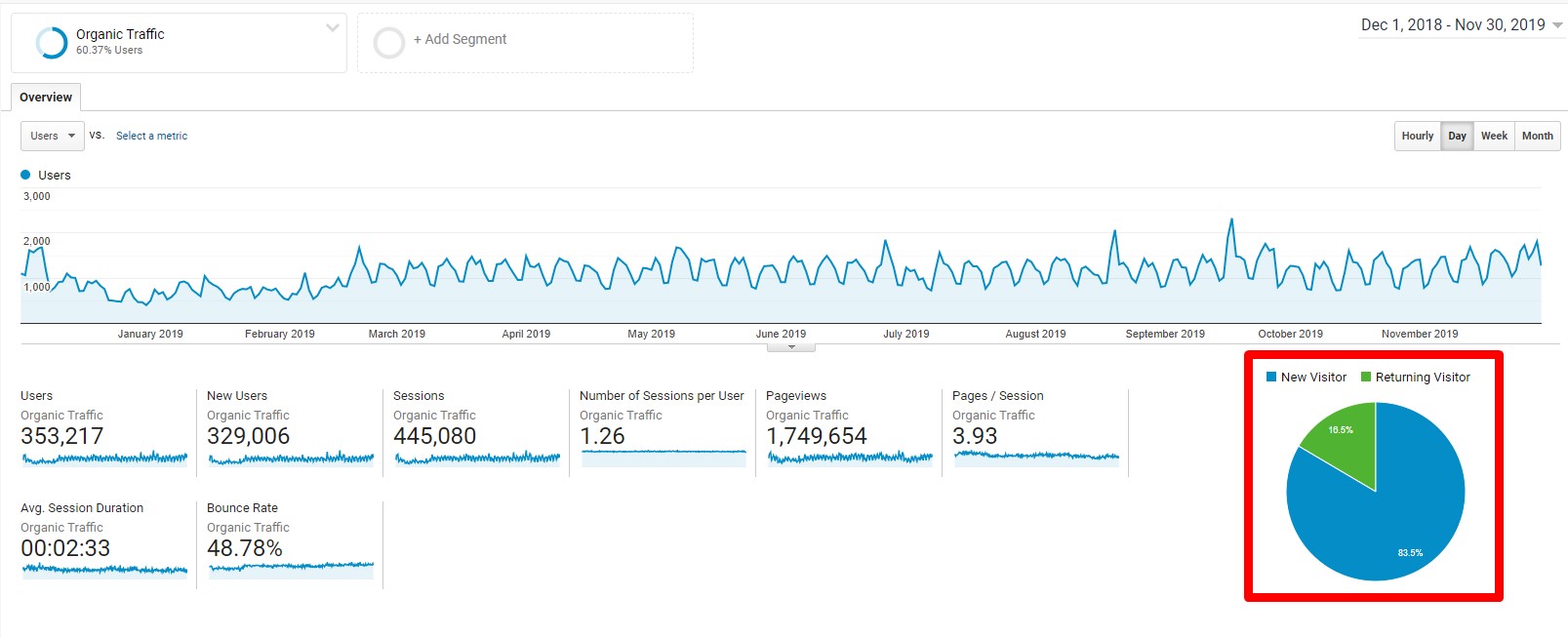
All businesses love their returning customers that stay loyal to you and your brand. This should also be true for your organic website visitors — people who respond to your website often represent your most valuable online customers who are more likely to convert multiple times.
There are two ways to check for this in Google Analytics: returning visitors and direct visitors. You can check the first under Audience > Overview, and looking at the green and blue pie chart. It’s great to have a lot of returning visitors to your site, but remember that new visitors are essential for your growth as well.
Direct visitors are people who enter your website directly in the URL bar to revisit your website, or who have it bookmarked. You can find this data by going to Acquisition > All Traffic > Channels and looking for Direct Traffic. You can also select Direct Traffic as a segment in most reports in Google Analytics.
11. Click-Through Rate (CTR)
A lot of people don’t see the significance of how you set up each page’s meta title and description. You can see the importance of the click-through rate that each of your pages gets from organic search results.
For example, if all your pages have titles or descriptions that are duplicated, too long, and/or are not optimized for the main keyword the page targets, you likely will have a very low CTR. That will affect how much traffic your page gets even if it has a good ranking.
It may also be that the page is not optimized for the right keywords and user intent. In this case, your page might be ranking for specific keywords that your page, meta title, and description are not optimized for.
You can see your organic CTR by page in Google Search Console, under Search Traffic > Analytics. Choose Avg CTR as a metric to display and sort your results from low to high. Look for pages that have a good ranking and lots of impressions, but a below-average CTR. Those are the pages you need to adjust.
12. Domain Authority / Domain Rating
If you want a good overall way to assess your SEO performance in one metric, then your website’s Domain Authority is arguably your best bet. It takes into account numerous metrics that search engines use when establishing its ranking on a given search.
In general, you will find that having a good Domain Authority rating has a strong correlation to organic rankings, traffic, conversions, etc. Any successful SEO campaign that is meant to generate backlinks, improve keyword rankings, and so on should result in increasing your Domain Authority.
If you want to check that over time to track your SEO performance, some tools have their version of Domain Authority. Moz, Ahrefs, Majestic SEO, Monitor Backlinks, and other full-service SEO tools are your best bets.
Summary
With these ways of tracking your SEO performance, you will be set up to assess the success or failure of your strategies accurately. You can also find opportunities to work on for your next campaign and to refine your approach to gain incremental progress over time continually.
You may find that, depending on your campaign, you don’t see that every method here is useful for you. The importance of this list is to give you a starting point as you set up your SEO performance tracking.
Hand off the toughest tasks in SEO, PPC, and content without compromising quality
Explore ServicesWritten by Jake Sheridan on January 30, 2020
Founder of Sheets for Marketers, I nerd out on automating parts of my work using Google Sheets. At Loganix I build products, and content marketing. There’s nothing like a well deserved drink after a busy day spreadsheeting.





